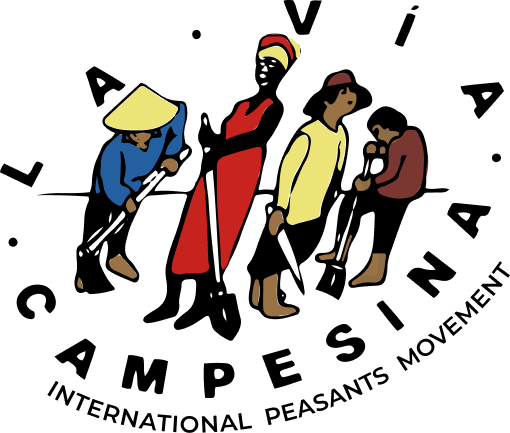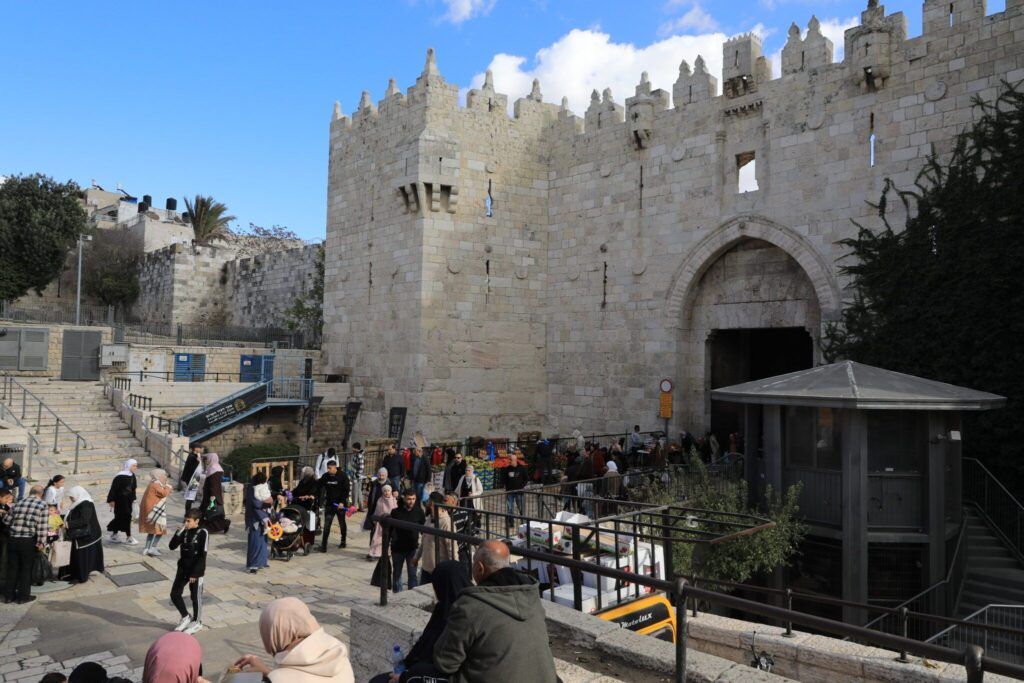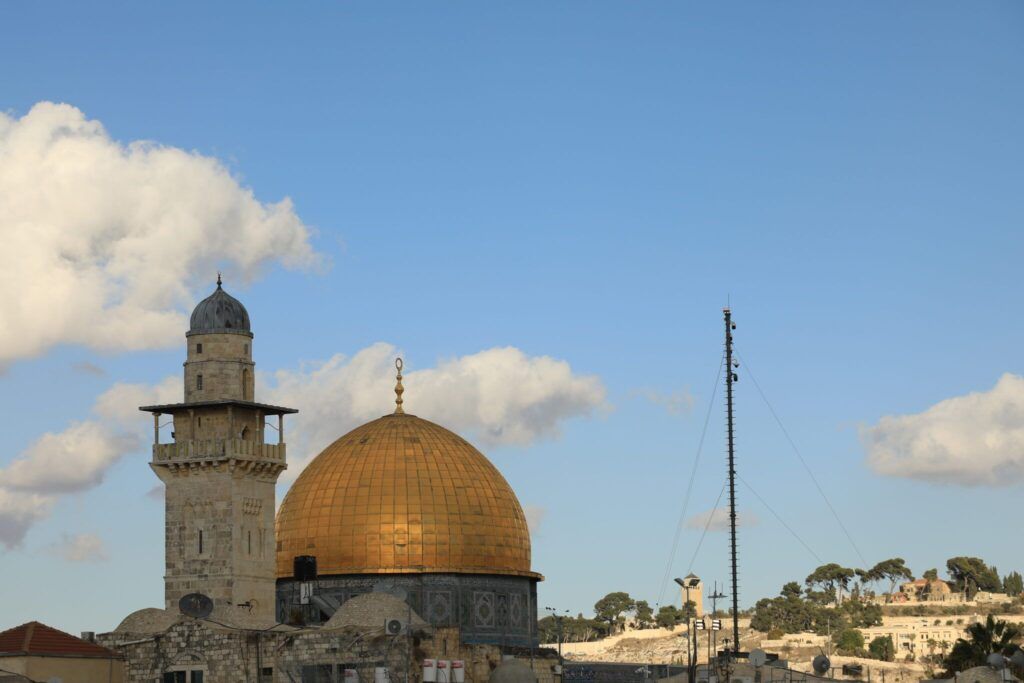La Via Campesina Delegation Visited Palestine in December 2024: Notes from their Daily Diaries [Part – 5]

From December 8 to 18, 2024, a delegation of nine peasant-farmers traveled to Palestine, in the West Bank. All their organizations are part of the international peasant movement La Via Campesina, which also includes the Palestinian organization UAWC (Union of Agricultural Work Committees) as a member. For many years, La Via Campesina has stood in solidarity with Palestinian peasants in their struggle against colonization, land and water grabs, and the numerous human rights violations they endure. However, since 2023, the scale of massacres in Gaza and the openly genocidal intentions of the far-right Israeli government have led La Via Campesina to intensify its solidarity work with Palestinian farmers. Organizing a delegation visit to the West Bank thus gradually became an imperative. Due to the obstacles posed by the Israeli state for accessing Palestinian territories, all delegates were European, hailing from the Basque Country, Galicia, Italy, Portugal, Ireland, and France. We, Fanny and Morgan, are both small-scale farmers, based in Ardèche and Brittany, and members of the Confédération Paysanne. The following texts are our journal from these ten days, which profoundly changed our lives and worldview. [ Access all the notes here].
Day 6 – Jerusalem
Fanny
East Jerusalem
We get up early to go to Jerusalem, very close to Ramallah, only a few kilometers away. For the first time this week, we had to leave Fuad, Sana, Aghsan and Tamam who cannot come with us. Palestinians from the West Bank need a permit to enter Jerusalem, and beyond its exorbitant price, it has become almost impossible to obtain it, the Israeli Police almost never granting it.
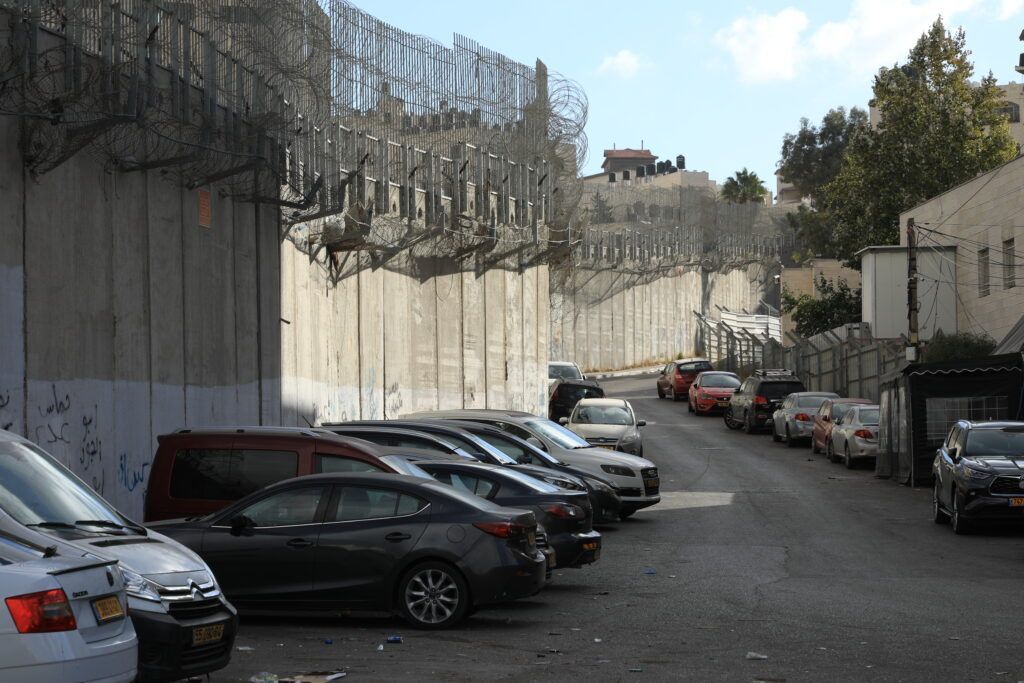
If a Palestinian is away from Jerusalem for a period of 6 years, they lose their status. 30,000 people who fled abroad during the war in 1967 were declared absent and lost their rights. The status of “resident” is very precarious and it is easy to “lose” it. Since October 7, if a Palestinian from Jerusalem posts the slightest information, image or statement about the genocide in Gaza on the social media, they lose their status. More than 2,850 people from East Jerusalem and 12,000 Palestinians from the West Bank have been arrested for this reason.
We can’t go there with Mustapha and the bus with the white plate that he drives, either. Therefore, it’s Naseer– who works at the UAWC and who has a “resident” card and a new driver with his colorful bus with plastic cactus decoration – who takes us there. We are lucky, there are not many people at the Qalandia checkpoint that separates the two cities, because often the waiting time is never-ending, as Naseer explains to us.
The soldiers signal us to stop, an Israeli soldier gets on the bus and checks all our passports. During all this time, not a single word is exchanged. No hello, no thank you, nothing. Everything happens in heavy silence; their suspicion is tangible. Politeness seems not to exist in times of war.
We pass, and no one on the bus flinches. With all the testimonies heard over the past four days, we have understood that the slightest misstep can make the whole story degenerate, that the smallest detail can tip the situation over, and above all, it can cause our Palestinian comrades to take risks.
Just after the checkpoint, we stop near the Wall. It is always so haunting, 11 meters high here, topped with electrified and barbed wire.
Since we are finally early, we hang around a little bit at the foot of the Wall. Not far from us, we see a man looking at us strangely. He is on the phone and pacing back and forth. With Morgan, it makes us question ourselves and feel uncomfortable. But in fact, it is he who is bothered by our presence.

Because a few minutes later, we see another man climbing the wall and then going down with a rope. Then he leaves in a car with the man on the phone. Naseer explains to us that it may be the boss who is coming to get his employee. A sad reality, but it doesn’t seem to be rare. In less than a week, this is the second time that we’ve seen Palestinians jump over the Wall.
This morning, we have an appointment with activists from The Civic Coalition for Palestinian Rights in Jerusalem. Zakaria begins by giving us a presentation, tracing the important dates and the different laws imposed by Israel since 1948. He tells us: “Today, it is the law of the strongest that prevails.” He explains that even if East Jerusalem is “Palestinian” according to the Oslo Accords, it is under Israeli authority, Israel having declared its annexation in 1980, even if this is not recognized by the international community.
Since 1952, Palestinians in Jerusalem have had the status of “residents”, while Israelis have had the status of “citizens”. The advantages of the resident status (compared to Palestinians in the West Bank) are access to a good health system, more jobs, being able to move around, to travel.
If a Palestinian is away from Jerusalem for a period of 6 years, they lose their status. 30,000 people who fled abroad during the war in 1967 were declared absent and lost their rights. The status of “resident” is very precarious and it is easy to “lose” it. Since October 7, if a Palestinian from Jerusalem posts the slightest information, image or statement about the genocide in Gaza on the social media, they lose their status. More than 2,850 people from East Jerusalem and 12,000 Palestinians from the West Bank have been arrested for this reason.
Many examples show us to what extent the Palestinians of East Jerusalem are pressed and cornered. The simple act of filing an application to get a building permit costs 45,000 euros on average, and since the vast majority do not have the means to do so, most of the time, Palestinians in Jerusalem build without permits. They have no choice, families are growing. Israel then took advantage of it to order demolitions. Since October 7, 255 buildings have been destroyed and more than 2,000 people have been displaced. There’s said to be around 25,000 “illegal” constructions. Zakaria explains that when you receive a demolition order, you have to pay -yourself- for the cost of having your house destroyed by bulldozers, and you can be sent to prison until you pay. It’s double punishment.
Schools are also suffering the full force of discrimination. There are scarcely 2,200 classes, school textbooks are censored and history is revisited (there’s a ban on talking about the Nakba, the Wall, etc.). 15,000 children have to go through a checkpoint every day to get to school. There is no gender mix and the school system is locked down by apartheid.
He also shows us how Jerusalem is completely surrounded by walls, Israel is dividing the West Bank in two parts, the North and the South, by installing huge colonies in very strategic places to connect them together. The Israeli state is trying to impose a majority of Israeli population in Jerusalem, on the one hand by pushing the Palestinians to go and live on the other side of the Wall, and on the other hand by attaching to the Jerusalem metropolitan area very large colonies that are currently in the occupied West Bank. So far, this strategy has not really worked, since more than 40% of the population of Jerusalem is Palestinian.
He tells us that since October 7, everyone has been focusing on Gaza and no one sees or reacts to the annexation of the West Bank and the expansion of the colonies. In East Jerusalem alone, 44 new colonies are already planned.
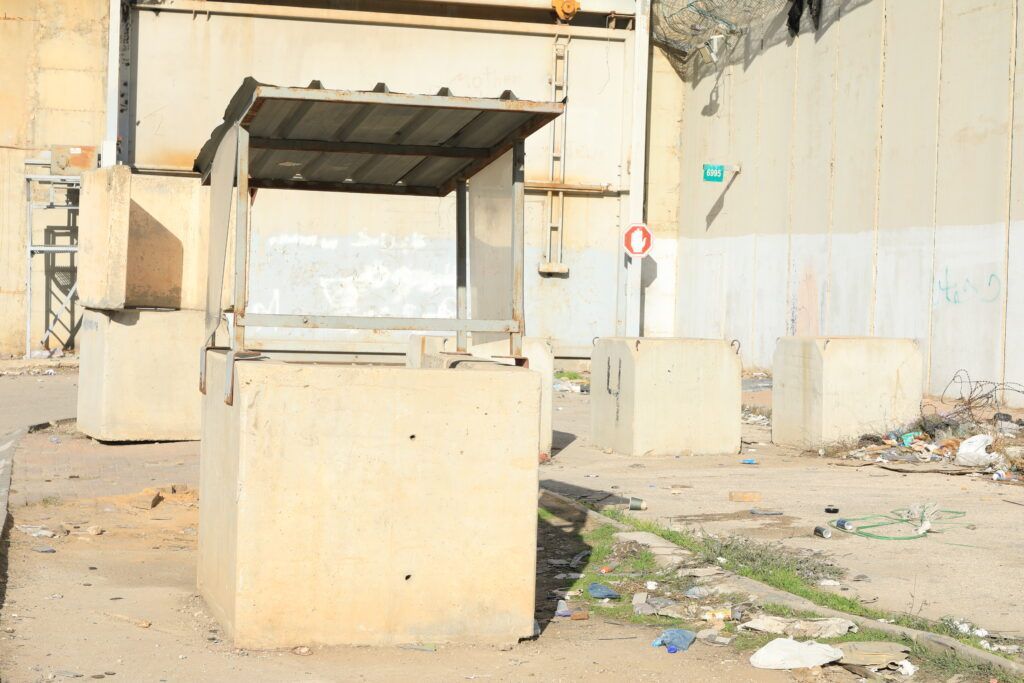
Schools are also suffering the full force of discrimination. There are scarcely 2,200 classes, school textbooks are censored and history is revisited (there’s a ban on talking about the Nakba, the Wall, etc.). 15,000 children have to go through a checkpoint every day to get to school. There is no gender mix and the school system is locked down by apartheid.
Zakaria projects a picture of Smotrich, the chairman of the new far-right party “Mafdal – Religious Zionism” and current Minister of Finance of Israel. In the image, he is offering 15,000 weapons to settlers in the West Bank to encourage them in their punitive expeditions against the Palestinian population. Last November, he announced that the annexation of the West Bank was planned for 2025, taking advantage of Donald Trump’s election to strengthen this project. We are horrified.
The representative of the association for the rights of women and children then takes the floor and begins by saying “They want us to live like animals”.
She describes how Palestinians in East Jerusalem are ready to accept unbearable conditions in order to retain their resident status and how this situation particularly impacts women who often find themselves alone in dealing with administrative constraints and the consequences on their daily lives. If a woman with Jerusalem resident status marries a Palestinian from the West Bank, the family must live separately, because the husband will never obtain resident status, and the woman cannot afford to lose it. “The Israeli occupation even decides who you should love.” Many families are therefore broken up, dispersed, and this weighs heavily on women’s lives. Many of them are the only head of the household, due to the fact that many husbands or sons are in prison. Therefore, many of them do informal and manual work at home, but Israel targets them with tax audits in order to track them down more effectively.
With all the construction constraints and the precariousness of Palestinians in East Jerusalem, there is major overpopulation, and it increases domestic violence. The stakes are huge in terms of mental health, traumatic stress, depression, anxiety and we don’t need a demonstration to be able to visualize the situation. We get back on the bus towards the Old City. We take Zakaria with us, and he makes us take a few small detours to show us how settlers have settled by force in the midst of Palestinian neighborhoods.
When they succeed in taking over the place, as on the lands seized in the West Bank, they plant their flag on top of their houses as a sign of conquest. Zakaria shows us a canopy installed in the middle of a small courtyard surrounded by Palestinian houses. He explains to us that Israeli settlers came every day in the summer to squat under the canopy, eat, take a nap. Just another way to exhaust the inhabitants, while frightening them, and slowly gaining ground. It is so cynical.
Then, we cross a huge colony, the “neighborhood” is drawn to the line, nothing sticks out, everything is clean and seems new. It is the first time, finally, that we find ourselves in the heart of a colony.
We – the 9 delegates from La Via Campesina – look everywhere and watch everyone who passes by. We need to understand who they are, and we want to think that maybe by scrutinizing them, we will succeed in understanding them better. They do not look like the people we met in the Jordan Valley. What jumps out at us, above all, is that there are lots of children, accompanied by their fathers (are women forced to say at home and take care of babies and meals?!). Men and boys from a very young age all wear a kippah and the famous “Payots” along their faces. But very quickly, we leave the colony and arrive in front of the old city, encircled by stone ramparts.
The Old City
Before entering the old city walls, on the Palestinian side, we eat our first falafel sandwich while sipping fresh guava juice. So tasty. Right next to the restaurant, there is a fish market. We like the atmosphere, it is lively, buzzing, and Carlos takes the opportunity to take lots of pictures.
Facing the Damascus Gate, or Bab el-Amud, located between the Christian and Muslim neighborhoods, we wait for Mahmoud who will guide us through the Old City. Mahmoud spent 18 years of his life in Israeli prisons. He seems to know all the alleys and dead-end streets of the old city.
When entering this “three times holy” city, you feel like entering a history book. Many images from films recounting the crusades come to mind. I also think of the Order of the Knights Templar, because where I grew up in Mont Pilat, there are Templar crosses carved on many houses, and their adventures in the Holy Land, as well as their mysterious treasure, have always captivated me.
We wander through the “Muslim” part of the city and we feel as if we were in a Moroccan medina. There are lots of open stalls, sellers of spices, cakes, crafts, shiny trinkets… We have become passing tourists again and it is quite light. But soon afterwards, Mahmoud makes us take a narrow passage that goes up to the roofs and there, right in the middle, stands a blue and white flag with the Star of David. The settlers impose themselves everywhere. Sofas and a coffee table with cups placed on it give us the impression that they have just left the place. We feel uneasy and we imagine how oppressive it must be for the inhabitants around.
Then, Naseer and Mahmoud want to take us to see the great Al-Aqsa Mosque with its golden dome shining in the sun. Before entering the esplanade where the mosque is located, there is a gate controlled by Israeli soldiers.
They refuse to let us in, arguing that we are not Muslims. It is Friday, the day of prayer and we learn that Muslim men under 50 are also banned from entering the mosque (too dangerous!?). I find it mind-boggling that they give themselves the right to ban Muslims from entering their own place of worship, a place that “belongs” to them, but I finally tell myself that Israel doesn’t even consider it so important. We try to gain access through another place, same answer, we give up.
We cannot access the Wailing Wall (or Western Wall), either, only reserved for Jews. Naseer would have refused to go there anyway, keeping the painful memory when, as a child, he was beaten up there. We do not ask any further questions, we do not insist.
We gain a bit of altitude and get a bird’s-eye view of the city, with the famous Wailing Wall below, the Al-Aqsa Mosque just above, and the Mount of Olives in the background. With Morgan, we are surprised and disappointed by this famous wall, because it is not at all impressive, or at least much less than in my memories of images seen on TV. On the other hand, what is obvious is the interweaving of buildings of the 3 religions, everything is tangled, with no demarcation. We understand that from a “physically” perspective, the different religions are inseparable and linked.
At nightfall, in the Jewish neighborhood, everything is closed, it is the beginning of the Sabbath. We start to come across more and more Orthodox Jews, dressed in a very particular manner. All men wear sidelocks and long beards, a black suit with a long coat sometimes, long white stockings, and this strange and imposing fur hat – the schtreinel. Women are dressed like grandmothers of former times, with long skirts, white stockings, flat heels, scarves tied behind the neck. 14-year-old girls have exactly the same look as their mothers. Almost all women have a stroller in their hands and children around. We understand that they have to repopulate the land of Israel.
It’s so difficult to take our eyes off them. I think of the TV series Unorthodox and it makes me shiver.
With Morgan, we are walking at the back, and we haven’t heard where we are going, when, following the group, we enter a house. There are lots of beautiful old black and white photographs on the walls, but no time to appreciate them, we have to follow the others who are going up an old wooden staircase. There are stained glass windows, carpets, it’s beautiful, but we still don’t know where we are. We arrive at a beautiful vaulted room, and find ourselves face to face with a very impressive man, in a black robe, with a long gray beard, a black hat and a massive gold pendant. Morgan and I feel completely destabilized, we have no idea who he is and what religion he represents. Once again, things are completely surreal.
I feel as if I were facing Albus Dumbledore in his office at the top of Hogwarts’ tower! In any case, that’s how I would describe it later to Sana, Tamam and Aghsan, who burst out laughing.
We are invited to sit down and we finally understand that we are meeting Archbishop Theodosios Atallah Hanna, of the Greek Orthodox Patriarchate. He speaks in Arabic, Naseer translates for us. He tells us that they are Christian Palestinians who are an integral part of the Palestinian people. He hopes that non-Zionist Jews will seize this moment in history to join their fight. He strongly affirms that they are against genocide and against all violence. He calls for a ceasefire and an end to the massacres. He talked to the press and asked all churches around the world to pray for Gaza and called for a boycott of Israel. “Everyone talks about peace, but where is it? Peace advocates have completely missed the core issue, which is justice.” Once again, we realize that the Christian and Muslim communities in Palestine are in very good terms, and that they are fighting together for the liberation of Palestine. You can feel the complicity and goodwill between him and Naseer and it is really comforting.
We learn that the Christian population in Palestine has fallen sharply, and is now only 1%, most of the Christians having emigrated given the context. Immediately afterward, we go to see the Church of the Holy Sepulcher where the tomb of Jesus Christ is located. The building is being renovated, so there is a lot of material and rubble stored in the entrance courtyard, and it kind of breaks the image that I had of it in my mind before arriving. We learn that several Christian “groups” share the space: Roman Catholics, Greek Orthodox, Apostolic Armenians, Copts, Ethiopian Orthodox and Syriac Orthodox.
I realize that despite my years of catechism, I know really nothing about religions! At the entrance of the church, there is the stone where the body of Jesus is said to have been laid so as to be washed and coated with ointment after his death. Because of the chaotic situation in the region, there are very few pilgrims present. But the few who are present are kneeling, and they all place their heads and hands on the marble while praying. Not far from there, a rock has not been covered because there is the blood of Jesus on it. We cannot go further into the building to visit it, because there are two masses being celebrated at that time.
At the entrance, there are also 11 columns representing the apostles (Judas is not there) and I see the pilgrims kissing one of the columns before entering, always the same one. It intrigues me. Being an atheist myself, I find it quite destabilizing to see humans venerating relics with such fervor. Once again, it is beyond my understanding. Here, as well, a minaret adjoins the Holy Sepulcher. It is incredible to see how this city mixes symbols and sacred places so much, everything is intertwined.
We leave “Christendom” to go and taste the best knafeh in Jerusalem according to Mahmoud, and then we go and have a tea or coffee on the terrace, after saying goodbye to him. There, we see more than a hundred Orthodox Jewish people parading in the pedestrian street. It’s quite impressive and we are not finding it easy to feel very comfortable here. We know that racism is very virulent in Jerusalem, and we feel like we have to be on our guard all the time.
In the meantime, we lose sight of Ollie and give Naseer a scare, as he has been playing the role of the teacher who counts and recounts his unruly flock since we entered the old city. We haven’t really made it easy for him today, between the hundreds of questions that we posed to him and our desire to discover everything! Ollie, after several minutes of stress, manages to find us, and we can return to the bus. We leave Jerusalem, we thank Naseer and his immense kindness, and we leave to join Mustapha and “our” bus, heading toward Hebron, in the south, where we will spend the next 2 days.
Hebron
We arrive in Hebron – the first gate that is the main access to the city is closed, the second one will be the right one. We happily find Fuad who is waiting for us outside the UAWC premises. We will be staying in a large apartment in the building. We barely have time to drop off our things before heading out again, as Fuad and his family have invited us over for dinner. His wife, his daughters and his sons welcome us warmly and invite us to take a sit in the living room to share another “light meal”. You’re kidding! Same as the day before at Tamam’s, the table is covered with lots of small dishes, each more appetizing than the previous one.
We eat, we make jokes, we tease each other. At the end of the meal, Fuad tells us about the night when Israeli soldiers came to their house and took him away after breaking everything (there are still traces of their passing on the walls). He was taken to be interrogated and tortured for 40 days. What Israel accused him of was that the actions carried out by the UAWC “changed facts on the ground”. This accusation would almost be amusing if it didn’t lead to such extreme violence – what we have seen these recent days is that the establishment of colonies “changes facts on the ground” and that Palestinian farmers are trying to resist at all costs. Fuad’s modesty prevents him from going into too much detail. He says that for 40 days, his family did not know where he was, did not know if he was still alive. We can hardly imagine the anguish of those endless days and nights… We listen, we say nothing.
He then explains that a few years ago, one of his daughters was very seriously ill. The only way to treat her was to take her to a hospital in Israel. Fuad and his wife had to struggle, take many steps and pay a lot of money to make this possible. But only his wife, as a mother, was allowed to accompany her. Fuad, unable to accept leaving his daughter far away from him when she was between life and death, decided to jump the Wall. He stayed hidden during the long weeks of hospitalization.
He finally recounts that occasion, last spring, when the whole family was invited for a meal at a relative’s house, and they were stopped on the road by Israeli soldiers. Their eldest son is 17 years old, and he is the perfect target for the soldiers, the prime terrorist suspect. They took his phone and managed to connect it to the internet. They scrolled through all the pictures and posts all the way back to October 2023. They found a photograph of Gaza under the bombs. They grabbed the teenager, pinned him to the ground and started beating him up, in front of his parents, his sisters and his 6-year-old brother.
Fuad wanted to intervene, “Take me in his place!” He found himself with the barrel of a gun against his temple, “You start the car and leave, or I’ll shoot!” Fuad had to leave. He brought his family to safety, and returned to the checkpoint. After three endless hours of waiting, his son was released, his body covered in bruises. I look at the faces of the children who are listening, who have also suffered this violence in their bodies. The eldest son is there, with us, reserved and smiling.
We are on the sofas, speechless.
Impressed, we look at this family who has experienced these injustices, who has faced authoritarian violence, and we see them so united and complicit. We are in awe. So much. And we wonder how many other Palestinian families have experienced this unbearable anguish. It feels like all the people we’ve met have experienced prison for themselves or for their loved ones, humiliations, the violence of soldiers or settlers.
Without any transition, we are served a delicious cake and juicy oranges with tea. We start laughing and joking again. The strength of life and sharing, again and again. We look at Fuad and his twinkling eyes, we see all his humility, his kindness, his determination, his quiet strength. Thanks for your trust.
